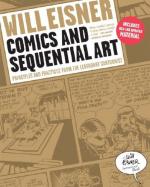
|
| Name: _________________________ | Period: ___________________ |
This quiz consists of 5 multiple choice and 5 short answer questions through Chapter 6.
Multiple Choice Questions
1. Through what must the artist seize attention and dictate the sequence?
(a) The structural thought.
(b) The sequence.
(c) The pages.
(d) The narrative.
2. What kind of vision is related to freezing a moment in an uninterrupted flow of action?
(a) Spatial.
(b) Circumspect.
(c) Dilated.
(d) Peripheral.
3. What is the absolute ratio of words to picture in comics?
(a) There is no absolute ratio.
(b) 3:1.
(c) 2:5.
(d) Twenty characters for three panels.
4. Images without words require what in the reader or viewer?
(a) Little knowledge.
(b) Technical practice.
(c) Belief.
(d) Extra sophistication.
5. What things are not described but added when words are coupled with images?
(a) Connections, webs, tangles.
(b) Sound, monologues, vocal patterns.
(c) Sound, dialogue, connections.
(d) Weight, height, style.
Short Answer Questions
1. How big is the simplified script when determining an agreement between artist and writer?
2. What must the artist deal with to decide when abbreviations or omissions are required?
3. When does a pause inevitably occur while reading?
4. What Spirit story written in 1947 mentions Yogi?
5. How does calligraphy relate to sound?
|
This section contains 238 words (approx. 1 page at 300 words per page) |

|




